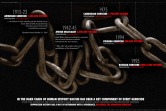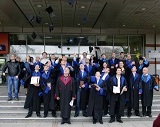Social stages of a genocide according to the fundamentals of crime
Print version: [armgenocide-en]
In general genocide takes place between two groups of people, the first group starts to divide themselves and the other group into “us” and “them”, and at the end the first group denies that by mass killings of members of the other group the perpetrators have committed any crimes.
The most detailed and analytic model of the genocide as a crime is presented by Gregory Stanton, The 8 Stages of Genocide, 1996y. Stanton claims that this stages are „predictable but not inexorable“.
|
Stage |
Characteristics |
|---|---|
|
1. Classification |
People are divided into “us and them” |
|
2. Symbolization |
Symbols combined with hate are links (are calling names) to the members of the hated group |
|
3. Dehumanization |
One group denies the humanity of the other group. Members of it are equated with animals, vermin, insects or diseases |
|
4. Organization |
Genocide is always organized. Special army units or militias are often trained and armed |
|
5. Popularization (Polarization) |
Hate groups broadcast polarizing propaganda |
|
6. Preparation |
Victims are identified and separated out because of their ethnic or religious identity |
|
7. Extermination |
It is “extermination” to the killers because they do not believe their victims to be fully human |
|
8. Denial |
The perpetrators deny that they have committed any crimes |
These are the social stages of growing (development) of a genocide. We can claim that after proving the existence of one stage, all the previous stages exist at some level in order to develop the current stage, if some previous stages are about a physical act, they have happened in the past in some enough volume. This is true even about the eight, last stage, which fully describes the crime of genocide.
About the last stage, that the committing of mass killings on people because of their ethnical and/or religious identity does not constitute any kind of a crime, the genocide is qualified as a crime against humanity. It is a standard practice from the court cases about crimes during the World War 2 that prescribed claim about such a crime, claim can not be lost by limitation (of any kind, even time).
It is widely claimed that the law is structured by couples of juridical hypotheses and consequences. This way the law is presented like „If <some crime is committed> it have to be applied <some judgment> with the aim of saving the justice.“ (with the power of a passed sentence to be retrieved the fair balance of rights in such a way that the crime has no effect on the it’s victim). Such patterns are directly applicable to any real life problem.
Not all government documents contains a direct life applicable pattern. Such texts are opinions/ advises (in general with propaganda purposes), unconditional conclusions and rules. This kind of texts don’t have in their own a concrete consequence, even a directly proclaimed hypotheses. The recognition of one historic events as a genocide is numbered among the last form of the law. This form of law is not directly, but indirectly applied by using analogy between the concrete real life problem and the problem which the official document solves. (Official documents do not always solve problems.)
The unilateral qualifying from the democratic representatives of one nation about one fact as a crime against humanity can not derive to an automatic and forcible sharing (agreeing) to the qualification from the all members of the nation. Not only because of the democratic elections of representatives by the majority group from the people, but even because of the freedom of thought and own (private) opinion. The recognition of the Armenian genocide, crime against humanity, is an ethical model of the leaders to the people.
But unequivocal expression of the recognition can cause statutory banning of the public deny of the already recognized genocide, if there is a general ban about denying genocide (and the unequivocal expression of recognition of genocide is treated as a part of the law).
The last stage of the genocide, because it is not tied to physical actions, but only with historical comprehensions about past acts, causes law forbidden of every expression which denies the historical events as a genocide (this kind of forbidden is called: hate speech).
The ban for a public denying of a genocide have to not be treated as a censorship of the thought (thought crime). The aim of hate speech is to protect the society from proclaiming of not acceptable claims and propaganda of the same. Having in mind the previous stages of genocide, hate speech according stage 5 are racist, sexists, xenophobic and other (summarized as propagation of hate because of an ethnical or religious identity), but according to stage 8 we have one way of a direct complicity and blessing by a direct (open) or indirect (hidden) method of the physical realization of the ideas from the previous 5-th stage.
In different countries are regulated different punishments about such kind of crimes. In the more countries the ban for expression and propaganda has jurisdiction only about the public society, the right for free expression of thought between friends and at home is protected.
In 2007 Swiss Judge Pierre-Henri Winzap convicts Turkish politician Dogu Perincek for denying the Armenian genocide (during a political speech in Lausanne) to a 90-days suspended jail term and fined him 3,000 Swiss francs ($2,461). The Turkish politician presented 90 kilograms historical documents as proves to the case and claimed that there were no genocide, but „reciprocal massacres“. According to the Swiss law it is bans denying, belittling or justifying any genocide. The maximum penalty is three years.
The Rome statute of The International Criminal Court defines the crime of genocide this way:
„For the purpose of this Statute, “genocide” means any of the following acts committed with intent to destroy, in whole or in part, a national, ethnical, racial or religious group, as such:
(a) Killing members of the group;
(b) Causing seriously bodily and mental harm to members of the group;
(c) Deliberately inflicting on the group conditions of life calculated to bring about its physical destruction in whole or in part;
(d) Imposing measures intended to prevent births within the group;
(e) Forcibly transferring children of the group to another group.“
This juridical texts speaks about the final physical act of genocide, by default these acts contain in their own the all previous stages of the genocide written previously in this paper.
The recognition of any genocide is an act of civilization grow, no matter who committed the genocide. The recognition of a genocide from the country who committed it (or who inherits the country which committed it) is an incredible act of civilization.
It have to be noted that the previous stages before the 5-th have an aim to describe the organization for physical realization of a genocide which is made by a government. According to propaganda of hate, organization of the members of this hate groups is not made by any government in general.
Genocide can’t be committed without going through the all its stages. When we talk about physical commitment it is accepted that it is by the force of mind of the country which organized the genocide.
— Added at September 19, 2008. Note: Above questions of no limitations by time of the crime of genocide and recognition of genocide as an act of civilizations are raised, now here are more deep explanations and proves engaged with concrete documents.
Source: Gerhard von Glahn, Law Among Nations, 1986
Statutory limitations
Many countries have enacted a statute of limitations, that is, the preclusion of prosecution after the expiration of a specific period since a given crime was committed. The application of such statutes to war crimes (and crimes against humanity) would, after a passage of time, prevent the prosecution and punishment of persons allegedly responsible for the offenses. Logically, therefore, the UN General Assembly, on November 26, 1968, approved by a 58-to-7 vote, the Convention on the Non-Applicability of Statutory Limitations to War Crimes Against Humanity. The convention, opposed by both United States and the United Kingdom, entered into force on November 11, 1970, after being ratified by all East European socialist countries, Mongolia, and Nigeria.
The Council of Europe also drafted its own European Convention on the Non-Applicability of Statutory Limitation to Crimes Against Humanity and War Crimes (Strasbourg), opened for signature on January 25, 1974.
Most significant, however, was the action of the West German parliament when after long debate, it struck down on July 3, 1979, its thirty- year stature of limitations. If this had not been done, Nazi-era criminals not yet apprehended would have been free from prosecution after December 31, 1979.
Recognizing genocide is an act of civilization
Convention on the Prevention and Punishment of the Crime of Genocide, Approved and proposed for signature and ratification or accession by General Assembly resolution 260 A (III) of 9 December 1948, entry into force 12 January 1951, in accordance with article XIII:
“The Contracting Parties,
Having considered the declaration made by the General Assembly of the United Nations in its resolution 96 (I) dated 11 December 1946 that genocide is a crime under international law, contrary to the spirit and aims of the United Nations and condemned by the civilized world,”
The charter of the International tribunal at Nuremberg listed in Article 6(a) a “new” category of crimes under international law, termed crimes against humanity.
This concept led to considerable criticism on the grounds that traditional international law had not recognized such an offense and that the trails of accused violators of such a new concept represented ex post facto, or retroactive, punishment.
— Added at January 13, 2009. Note: On the “that the committing of mass killings on people because of their ethnical and/or religious identity does not constitute any kind of a crime, the genocide is qualified as a crime against humanity”. I feel myself fool that I have failed to present all the important aspects and characteristics of the genocide intent and its relations to crimes against humanity.
In February 20, 2003 a report on “The Applicability of the United Nations Convention on the Prevention and Punishment of the Crime of Genocide to Events which Occurred During the Early Twentieth Century” by the International Center for Transitional Justice (ICTJ) stated that “…at least some of the perpetrators of the Events knew that the consequence of their action would be the destruction, in whole or in part, of the Armenians of Eastern Anatolia, as such, or acted purposely towards this goal, and, therefore, possessed the requisite genocidal intent.” The report concluded that “…the Events, viewed collectively, can thus be said to include all of the elements of the crime of genocide as defined in the [UN] Convention, and legal scholars as well as historians, politicians, journalists and other people would be justified in continuing to so describe them” (p. 17).





Vapid says : I absolutely agree with this !
vapid
June 2, 2008 at 19:47
[…] Pour consulter l’article en anglais, cliquez ici […]
UGAB Europe » Blog Archive » Étapes d’un génocide : principes fondamentaux
June 16, 2008 at 12:34
[…] here to consult the […]
AGBU Europe » Blog Archive » Social stages of genocide according to the fundamentals of crime
June 17, 2008 at 11:21
Somehow i missed the point. Probably lost in translation :) Anyway … nice blog to visit.
cheers, Performance.
Performance
June 19, 2008 at 08:48
I really like how the website has a brief description rather than a whole paragraph at the top describing the circumstances or the criteria of the genocide depending on the different stages. By having a brief description it allows the reader to use their imagination to what they think or know about genocide which would make them further their educatioin on the topic at hand, depending on the type of person they are.
*Rachel*
rachel
January 6, 2009 at 06:41
[…] Recognition of human rights has retroactive application. In the aspect of genocide: Law in general has no power to make people find the insight definition of the man as an enough characteristic to describe concrete behaviour or apply judgement, stereotype. Man is born with the understanding that he is different than others and only not-civilized worlds tie the ethnic identity of the man with its life. Someone commits crime when he has an intent to and understands that his actions are wrong, in general law has non-retroactive application and is publicly aware, by definition, to everyone after it receives its statute of law in power. Concerning human rights, law only discovers, like Physics discovers the laws of nature, the insight definition of the man. Human rights are not bind with views of future development of economics. Law can punish and is free to define behaviours when the letter cases are shared points of more than one human right (in order to say which human right is more valuable/important in this concrete situation), or no human right is found. Genocide, as destruction of a whole specie in nature, remains insgihtly understood from people committing this action as destroying the insight definition of the man- its concrete ethnical, moral (concerning religion genocide), or racial diversity. By separating people because of their identity you understand that you commit action denying the constitution of law, someone can be charged only on an informed choice (rule determined by the human rights of freedom). People understand the religious, ethnical and racial diversity of the man, this is a fact and can only be cited in science, but not introduced as new legislation, or a new assumption. If the equality of the man (in ethnical, racial or religious aspect) is confirmed in the law, everyone, by force of the law, is aware of the insight ethnical, racial and religious diversity of himself- the man. [Social stages of a genocide according to the fundamentals of crime, https://garabedyan.wordpress.com/2008/05/11/genocide/%5D […]
Notes on Armenian Genocide Recognition « Garo Garabedyan- a private blog
April 29, 2009 at 10:23